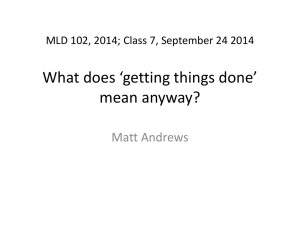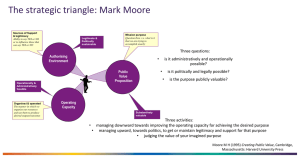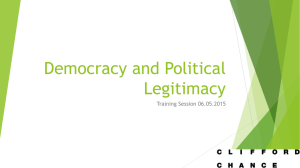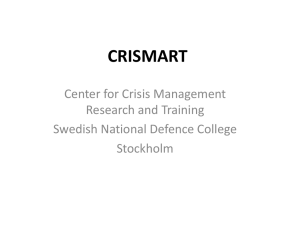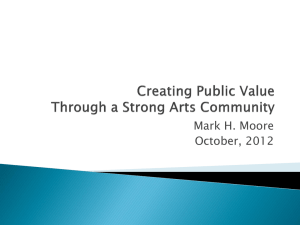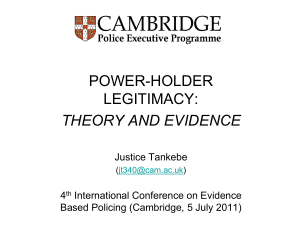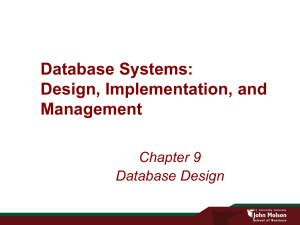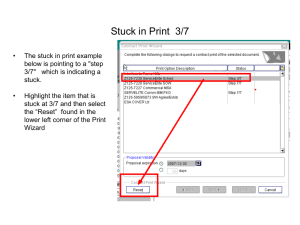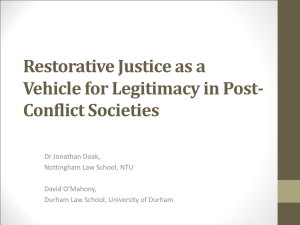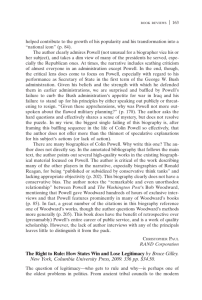Class10MLD1022014
advertisement
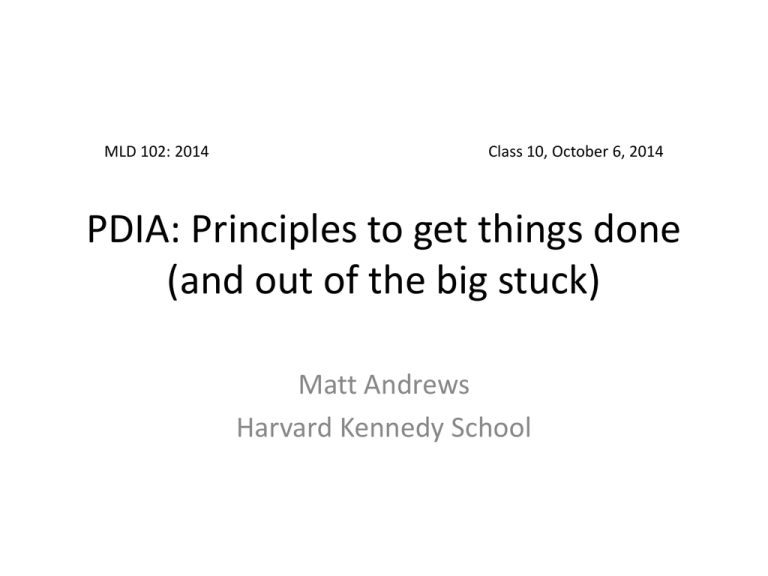
MLD 102: 2014 Class 10, October 6, 2014 PDIA: Principles to get things done (and out of the big stuck) Matt Andrews Harvard Kennedy School So far • We have gaps in many development interventions – Where implementation does not happen – De jure is better then de facto – Concentrated is better than deconcentrated, etc. • We have many strategies/tools to close these gaps – Both policies and management mechanisms • Management tools: Mostly classical administrative and NPM • But the gaps fester, despite the tools – Largely because of capability traps • Organizations/governments are in a Big Stuck • Chasing external answers that give external legitimacy – Good, better and best practice policies and management solutions – That often fail to offer real solutions and improved functionality – Because they are beyond abilities (external load bearing) or are adopted simply for external support (isomorphic mimicry) The Big Stuck as I see it: Too much development =isomorphic mimics or effervescent bubbles External legitimacy (maintaining External support By complying with Procese agendas) Zombeta…assuming functionality will follow? But no improvement in functionality…so A mimic without results Nomburo…assuming legitimacy will follow? Where we start But no legitimacy: effervescent bubble Functionality (achieving goals with the right people and participation) So…what’s next? Today’s class • How do you get out of a Big Stuck? • Let’s consider the two experiences of policy and management reform in the case reading – Malaysia and Burkina Faso • Discuss your answers to the following table in your teams: Malaysia How is it successful? What drives change? How does the change process work? Who drives change? Burkina Faso Malaysia Burkina Faso How is it successful? Looks good. External legitimacy at first…but not much more Looks strange, limited, They are ‘finding and fitting’ but much quick progress, a solution using a fitting with functional results, strategy we call much to build on. PDIA: What drives change? External answer introduced by narrow profession How does the change process work? Introduce external answer and expect implementation, use, and roll out Who drives change? Narrow group (i) Start with problems, Internal problem that (ii) Iterate with experiments, gets unpacked trying differentand things, with receives attention learning, much experiential (iii) Building authority and Experiment with ideas, engagement as you proceed, (iv) contextually get Producing results, learn what relevant hybrids that deliver works, build authority, Functionality and legitimacy diffuse, try more (through functionality) Broad, expanding group PDIA: Basic principles in a picture External legitimacy (maintaining External support By complying with Procese agendas) iii. Learn from first step, build with new intervention Identify a problem where authority allows some Where action; Take a we start small step to improve functionality iv. Repeat. Until problem solved. i. ii. Build authority And legitimacy based on early results Functionality (achieving goals with the right people and participation) technical sectors—that we propose PDIA as a pragmatic alternative. PDIA: a contrast with conventional approaches Table 1: Contrasting current approaches and PDIA Elements of approach What drives action? Planning for action Feedback loops Plans for scaling up and diffusion of learning Mainstream Development Projects/Policies/Programs Externally nominated problems or ‘solutions’ in which deviation from ‘best practice’ forms is itself defined as the problem Lots of advance planning, articulating a plan of action, with implementation regarded as following the planned script. Monitoring (short loops, focused on disbursement and process compliance) and Evaluation (long feedback loop on outputs, maybe outcomes) Top-down—the head learns and leads, the rest listen and follow. Problem Driven Iterative Adaptation Locally Problem Driven— looking to solve particular problems ‘Muddling through’ with the authorization of positive deviance and a purposive crawl of the available design space Tight feedback loops based on the problem and on experimentation with information loops integrated with decisions. Diffusion of feasible practice across organizations and communities of practitioners Do we always need PDIA? No. sometimes you can just move ahead with an external solution It depends on the nature of your task: Is it simple, complicated, or complex? (Allen, Glouberman and Zimmerman) You address simple and complicated tasks with ‘solutions+rational management’….But complex tasks demand a different approach How you address complicated tasks Role defining – setting job and task descriptions Decision making – find the ‘best’ choice How you address complex tasks Relationship building – working with patterns of interaction Sense making – collective interpretation Tight structuring – use chain of command Loose coupling – support communities and prioritise or limit simple actions of practice and add more degrees of freedom Knowing – decide and tell others Learning – act/learn/plan at the same what to do time Staying the course – align and maintain Notice emergent directions – building on focus what works Taylor, Weber, much of NPM My view of development • We have done pretty well with the simple and complicated stuff • But complex tasks, problems, systems still confound us – Challenges with learning in our schools – Gaps with polio vaccinations – Getting civil servants to use shiny new systems, best practices • So we need something like PDIA – To help us find and fit policy and management solutions – That fit the contexts in which we are working Others have argued similarly… Chris Pollitt suggests lessons from past reforms tell us that… 1. 2. 3. 4. 5. 6. 7. Big models, such as NPM or ‘good governance’ or ‘partnership working’, often do not take one very far. The whole idea that there is one model or set of principles that can or should be applied everywhere is suspect. Task differences really do matter. Change is always political as well as managerial/organizational. Change is usually saturated with vested interests, including consultants/advisors, and the existing public service staff. To conceptualise it as a purely technical exercise would be naïve. Successful PMR is frequently an iterative exercise, over considerable periods of time. It does work sometimes! And many of the principles of PDIA are not new… • Korten: participatory development (1980) – Contrasts ‘blueprint’ and ‘learning process’ – Emphasizes working in the context, learning what fits through action engagement, and then diffusing the new solutions • Rondinelli: the changing face of development problems (1982) – Noted that problems were getting more complex – Asks: “If control-oriented planning and management procedures are neither effective nor appropriate in coping with the complexity and uncertainty inherent in development activities, what alternatives do international development organizations and governments in developing states have for dealing with these problems more effectively?” – Suggests: “Effective development administration requires managers who can facilitate rather than control the interaction of those individuals and groups who have the bits of knowledge and resources needed to change undesirable conditions, and the experience and judgment to define what the undesirable conditions are. It calls for skilled people who can act as catalysts, mobilizing those whose support or commitment is needed to make projects relevant and successful. it demands technicians and administrators who can respond creatively, appropriately, and quickly to changes, who are willing and able to seek out and correct mistakes as they are discovered, and who can plan and manage simultaneously.” • And many theories of change influence our thinking… Stachowiak Next class…context • A key issue in PDIA – Finding and fitting solutions that fit context • So what is it about context that matters? • And how do we ‘see’ it? • We will look at a contemporary (new) case of regulatory policy reform in the USA – Where govt. is not ‘getting it done’ – And we will ask ‘why?’ – What contextual factors get in the way of reform? • And we will think beyond this to a basic approach to understanding what it is that matters about context…
